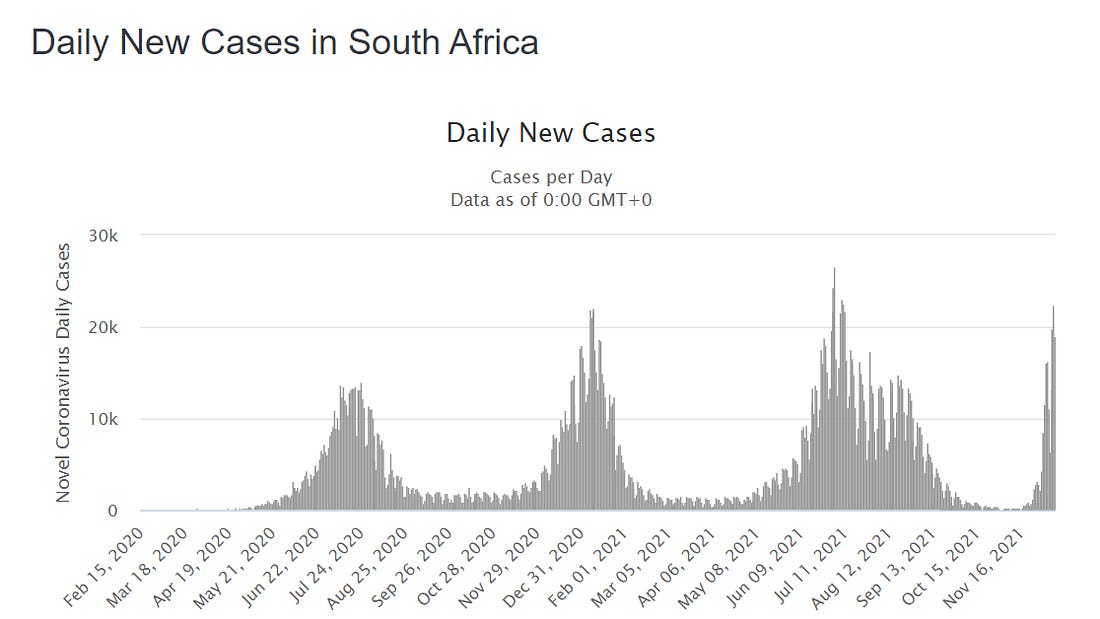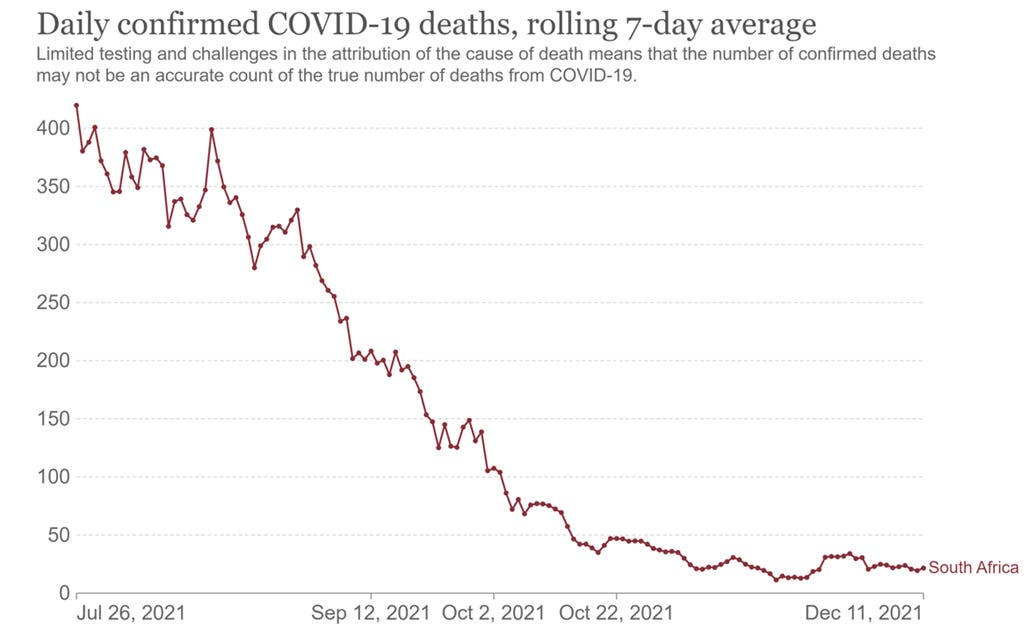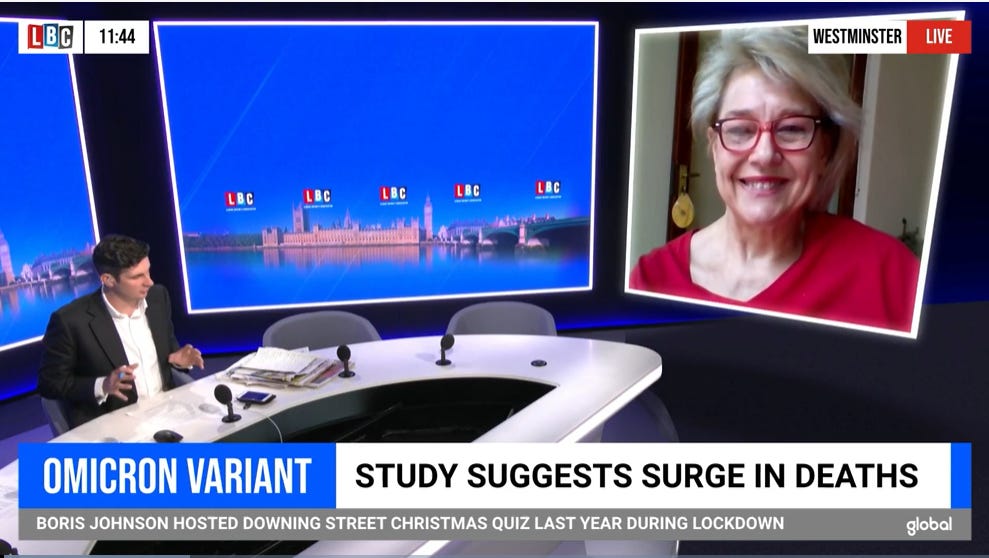
Science – or Shots in the Dark?
FORENSIC
With governments around the globe introducing booster shots for SARS-CoV-2 and in many instances formerly mandating them, or via severe restrictions, effectively mandating them by other means – they are making a serious mistake.
What we have masquerading as science throughout the course of this pandemic resembles more political scientism. But that works only so far; eventually, you will come unstuck as the arc of reality bends back to truth.
The latest variant, Omicron, is being used to promote fear and more lockdowns, with new laws mandating shots and restricting freedoms. The data do not support any of those actions.
We can see a rise in cases in South Africa, but deaths are unremarkable.
Fig.1 Daily New Cases In South Africa
Source: Worldmeters
Fig. 2 Daily Confirmed Covid-19 Deaths In South Africa
Source: Ourworldindata
The evidence supports a mild disease of low risk.
Prof. Jacques Fantini, expert in biochemistry and molecular biology, and developer of the T-index or transmissibility index – for accurately measuring viral transmission, wrote an expert opinion in the French Daily News.
In order to know more about its contagiousness, I applied to this variant [Omicron] the T-index analysis, which had allowed me, since the appearance of the Delta variant last April, to anticipate its expansion at the world level.
He calculated that the Omicron variant has a T-index of 3.90 – compared to Delta of 10.67, and concluded:
It is therefore a priori less transmissible than Delta, which remains to this day the variant with the highest T-index.
Importantly, he points out that Omicron mutations do not fit a logical evolution and may reflect the product of infection of an immunocompromised host or as a result of treatments including vaccination. That is highlighted by changes in the N terminal domain (NTD) of the virus:
The mutational profiles of NTD and RBD suggest that neutralizing antibodies will have very low activity on this variant.
In contrast, the facilitating epitope of NTD (ADE epitope) is also destroyed by the Omicron Spike rearrangements, further emphasizing the lack of logic in this exaggerated mutational profile.
The head of the South African Medical Association, Dr Angelique Coetzee, was interviewed on LBC the day before this article was published and agreed with the Professor, and the evidence we have discussed.
She echoed her initial claims that Omicron is a relatively “mild” variant of coronavirus, which sees greater transmission yet lower rates of hospitalisation.
Source: LBC
A quick look at the lower third across the LBC screen couldn’t be more contrasting:
Source: LBC
But the disconnect between reality and science and politically driven fearmongering is going to cost lives. And I am not addressing here the very real prospect of serious adverse effects from vaccination. What I am referring to is the immuno-prohibitive effect of multiple shots, which in the face of a very mild variant such as Omicron may not be problematic, but for how long will we get lucky?
A paper by Horndler et al. entitled Decreased breadth of the antibody response to the spike protein of sars-cov-2 after repeated vaccination demonstrated not just the futility of multiple doses of the Covid-19 vaccines but also the danger.
We have been hearing for some time now how antibody levels are boosted significantly by administering additional vaccines and that’s a good thing, but Horndler and colleagues disagree:
Interestingly, the titers of IgG1 generated in response to two doses (PD2) of either Moderna or BNT were not significantly higher than those generated in response to the first priming dose (PD1)
They identified significant failings with standard antibody tests.
Serological tests are usually established by detecting the presence of viral antigenspecific IgG or IgM in the serum of individuals using recombinant fragments of the S or N proteins and tests based on ELISA or lateral flow assay11,12. A disadvantage of those tests is that neutralizing antibodies are not directed against the N protein and that recombinant fragments of the S protein miss the quaternary structure of the protein trimer, which is the native form of the spike protein in the viral envelope. Therefore, part of the neutralizing antibodies directed against the native S trimer could be missed in serological tests based on the expression of recombinant proteins.
They remedied those problems and built a more sensitive system to accurately measure antibody activity. The results throw a whole new light on the global push for repeat vaccinations.
A comparison of the relative reactivity of sera from vaccines with those of people recovered from infection in 2020 and 2021, showed that antibodies produced in response to the second dose of either of the three vaccines were relatively less reactive with the Alpha strain than those produced by natural infection not only in 2021 but also in 2020 (Fig. 2C). Those results suggest that the booster immunization with the second dose of the three vaccines, based on the sequence of the Wuhan strain, might impoverish the reactivity of the antibodies with emergent VOC of SARS-CoV-2.
Not only did they establish that a second vaccination did not significantly improve antibody levels compared to the first (apart from Astrazeneca, which started out with lower levels), they also demonstrated that the ability of vaccine-induced antibodies to recognise a variant of concern was reduced after the second dose. The same level of antibodies with reduced affinity for variants is a recipe for enhancement of infection (ADE/OAS).
Fig. 3 Relative reactivity of the sera tested against the Alpha, Delta and Kappa variants versus the Wuhan strain
The charts demonstrate a reduced ability of mRNA Covid-19 vaccines to recognise Alpha, Delta & Kappa variants after the second dose (PD2).
It’s worth repeating the researchers’ Ominous statement:
[The] results suggest that the booster immunization with the second dose of the three vaccines, based on the sequence of the Wuhan strain, might impoverish the reactivity of the antibodies with emergent VOC of SARS-CoV-2.
Some may find it incredulous, but what they are describing is a known effect, and the researchers are clear about that:
This is somehow expected since repeated immunization with the same antigen sequence leads to the generation of higher affinity antibodies that fit better the epitopes of the immunogen. This increase in affinity has the negative side effect of reducing the “breadth” of the antibodies, that is, their capacity to bind to epitopes that differ slightly from those of the immunogen.
Each repeat vaccination increasingly blinds your antibodies to any new, sufficiently different versions of that virus – a new variant.
And where do those new variants come from?
Wang et al. in Mechanisms of SARS-CoV-2 Evolution Revealing Vaccine-Resistant Mutations in Europe and America address that question:
By tracking the evolutionary trajectories of vaccine-resistant mutations in more than 2.2 million SARS-CoV-2 genomes, we reveal that the occurrence and frequency of vaccine-resistant mutations correlate strongly with the vaccination rates in Europe and America.
Are we driving the very problem that we are trying to avoid? And for what, if it’s not effective?
There are arguments regarding the degree to which the immune system has back-up mechanisms if one component such as antibodies is compromised. Proponents favour that cytotoxic T-cells will take up the slack, and I hear that repeated often. Those are complex immunological arguments. Time will tell.
But what I do know is, it is foolish and dangerous in the extreme to keep vaccinating against the evidence and threaten such a problem, when it couldn’t be clearer: it won’t work (how many shots is Israel on now!) and it will diminish your ability to fight life-threatening pathogens.
How long before we bet on the wrong card?
Politicians are playing with people’s lives.
Source

••••
The Liberty Beacon Project is now expanding at a near exponential rate, and for this we are grateful and excited! But we must also be practical. For 7 years we have not asked for any donations, and have built this project with our own funds as we grew. We are now experiencing ever increasing growing pains due to the large number of websites and projects we represent. So we have just installed donation buttons on our websites and ask that you consider this when you visit them. Nothing is too small. We thank you for all your support and your considerations … (TLB)
••••
Comment Policy: As a privately owned web site, we reserve the right to remove comments that contain spam, advertising, vulgarity, threats of violence, racism, or personal/abusive attacks on other users. This also applies to trolling, the use of more than one alias, or just intentional mischief. Enforcement of this policy is at the discretion of this websites administrators. Repeat offenders may be blocked or permanently banned without prior warning.
••••
Disclaimer: TLB websites contain copyrighted material the use of which has not always been specifically authorized by the copyright owner. We are making such material available to our readers under the provisions of “fair use” in an effort to advance a better understanding of political, health, economic and social issues. The material on this site is distributed without profit to those who have expressed a prior interest in receiving it for research and educational purposes. If you wish to use copyrighted material for purposes other than “fair use” you must request permission from the copyright owner.
••••
Disclaimer: The information and opinions shared are for informational purposes only including, but not limited to, text, graphics, images and other material are not intended as medical advice or instruction. Nothing mentioned is intended to be a substitute for professional medical advice, diagnosis or treatment.








